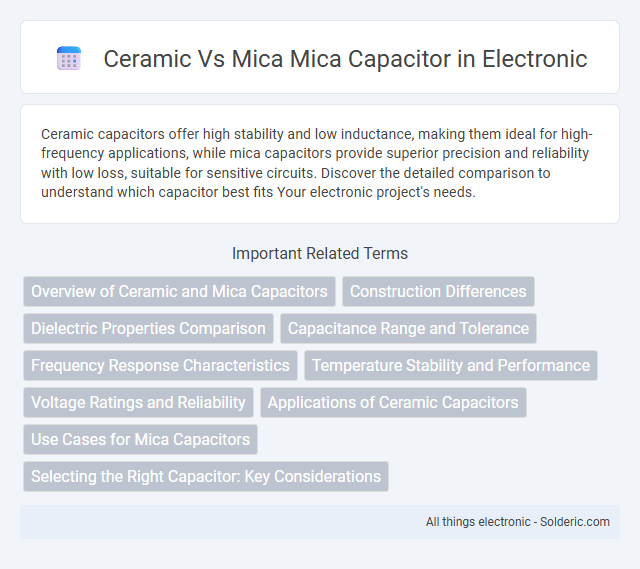Ceramic capacitors offer high stability and low inductance, making them ideal for high-frequency applications, while mica capacitors provide superior precision and reliability with low loss, suitable for sensitive circuits. Discover the detailed comparison to understand which capacitor best fits Your electronic project's needs.
Comparison Table
| Feature | Ceramic Capacitor | Mica Capacitor |
|---|---|---|
| Dielectric Material | Ceramic | Mica |
| Capacitance Range | 1 pF to 100 uF | 1 pF to 0.1 uF |
| Voltage Rating | Up to 50 kV | Up to 1000 V |
| Tolerance | +-5% to +-20% | +-1% to +-5% |
| Temperature Stability | Moderate (Class 2 and 3), High (Class 1) | Excellent |
| Frequency Response | Good | Excellent |
| Size | Smaller, compact | Generally larger |
| Applications | General purpose, bypass, decoupling | High-frequency circuits, precision timing |
| Cost | Low | Higher |
| Reliability | Good, but lower than mica | Very high, long-term stability |
Overview of Ceramic and Mica Capacitors
Ceramic capacitors utilize a ceramic dielectric and are known for their high capacitance values in small sizes, making them ideal for general-purpose applications and high-frequency circuits. Mica capacitors use mica as the dielectric material, offering superior stability, low loss, and precision, which is essential for RF applications and timing circuits requiring minimal temperature coefficients. The choice between ceramic and mica capacitors depends on factors such as tolerance, frequency response, and environmental stability.
Construction Differences
Ceramic capacitors consist of a ceramic dielectric material sandwiched between metal electrodes, resulting in a compact multilayer structure that offers stability and high capacitance values. Mica capacitors use natural mica as the dielectric, layered with metal foil or silver film electrodes, providing superior precision and low loss characteristics. The inherent structural variance affects their performance, with ceramic capacitors favoring high-frequency applications and mica capacitors excelling in accuracy-sensitive circuits.
Dielectric Properties Comparison
Ceramic capacitors typically use barium titanate or similar ferroelectric materials, offering high dielectric constant values ranging from 1000 to 15,000, which provides greater capacitance in a smaller volume but results in higher dielectric losses and temperature-dependent capacitance. Mica capacitors utilize natural or synthetic mica as the dielectric, characterized by a stable dielectric constant around 6 to 8, excellent electrical insulation, low dielectric loss, and superior temperature stability, making them ideal for precision applications. The choice between ceramic and mica dielectrics depends on the required capacitance density, stability, and loss characteristics for specific electronic circuit applications.
Capacitance Range and Tolerance
Ceramic capacitors typically offer capacitance values ranging from a few picofarads (pF) up to several microfarads (uF), with tolerance levels commonly between +-5% to +-20%, making them suitable for a wide variety of electronic circuits. Mica capacitors, however, provide more precise capacitance values usually in the picofarad range, with exceptionally low tolerance levels often around +-1% or better, ideal for high-frequency and precision applications. The lower tolerance and stable capacitance of mica capacitors make them preferred for RF circuitry, while ceramic capacitors are favored for general-purpose and cost-sensitive designs.
Frequency Response Characteristics
Ceramic capacitors exhibit excellent high-frequency response due to their low equivalent series inductance (ESL) and dielectric stability, making them ideal for RF applications. Mica capacitors provide superior frequency stability and low loss at microwave frequencies, delivering consistent performance under varying environmental conditions. The choice between ceramic and mica capacitors depends on the required frequency range and precision, with mica favored for ultra-high-frequency circuits and ceramic preferred for general high-frequency use.
Temperature Stability and Performance
Ceramic capacitors exhibit excellent temperature stability with Class 1 types like C0G/NP0 maintaining consistent capacitance across wide temperature ranges, ideal for precision applications. Mica capacitors provide exceptional performance with ultra-low loss and highly stable capacitance values over temperature variations, making them superior for high-frequency and RF circuits. Temperature coefficients in mica capacitors are typically far lower than in most ceramic dielectrics, ensuring reliable performance under thermal stress.
Voltage Ratings and Reliability
Ceramic capacitors typically offer higher voltage ratings, often reaching up to several kilovolts, making them suitable for high-voltage applications, while mica capacitors generally provide moderate voltage ratings but exhibit superior stability and low loss characteristics. Mica capacitors are renowned for their exceptional reliability and long-term stability under varying environmental conditions, whereas ceramic capacitors may experience capacitance drift and microphonic effects over time. Choosing between these depends on your need for high voltage endurance versus consistent performance and reliability in precision circuits.
Applications of Ceramic Capacitors
Ceramic capacitors are widely used in high-frequency applications, such as RF circuits and microwave devices, due to their low equivalent series resistance (ESR) and excellent temperature stability. They are ideal for decoupling and bypass applications in power supply lines of computers, mobile phones, and automotive electronics. Their compact size and reliability make them essential components in consumer electronics, telecommunications, and industrial control systems.
Use Cases for Mica Capacitors
Mica capacitors excel in high-frequency applications due to their superior stability, low loss, and precision compared to ceramic capacitors, making them ideal for RF oscillators, transmitters, and precision timing circuits. Their exceptional temperature stability and reliability in harsh environments suit military, aerospace, and high-end audio electronics. If your project demands consistent performance and minimal dielectric absorption, mica capacitors provide unmatched advantages over ceramic types.
Selecting the Right Capacitor: Key Considerations
Selecting the right capacitor involves evaluating factors like capacitance stability, voltage rating, dielectric type, and temperature tolerance. Ceramic capacitors offer high capacitance in small sizes with low ESR, ideal for high-frequency applications, while mica capacitors provide superior precision and stability, making them suitable for RF and timing circuits. Consider Your application's frequency, stability requirements, and environmental conditions to determine whether a ceramic or mica capacitor best meets Your performance and reliability needs.
Ceramic vs mica mica capacitor Infographic

 solderic.com
solderic.com